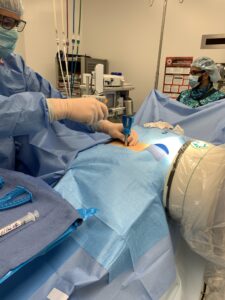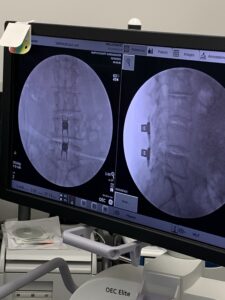Thoracic Kyphoplasty and Vertebroplasty are medical procedures that treat compression fractures in the vertebrae of the spine. A fractured vertebra can cause significant pain. Without treatment, it will eventually heal, but its height will not be restored, potentially leading to kyphosis, or a humped spine. Thoracic kyphoplasty and vertebroplasty repair the damage to the vertebral body and offer spinal cord pain relief while restoring spinal vertebrae to their correct height and lessening the chance of further fractures and complications.
Causes of Vertebral Compression Fractures (VCF)

A leading cause of VCF is osteoporosis or depletion of calcium in the bones, which makes them at risk from fractures. The majority of people with osteoporosis are elderly men and women and post-menopausal women, and most osteoporosis-related fractures are to the hips and spine.
Diseases that weaken the bones, such as bone marrow cancer and vertebral hemangioma, can also lead to VCF. When bones are weakened, even small movements such as coughing, sneezing, or lifting an item can cause vertebral compression fractures.
In younger, healthy people with strong bones, injury is the leading cause of VCF.
Effects of Vertebral Compression Fractures
Vertebral compression fractures can cause pain in the back, arms, and legs, ranging from minor to debilitating. Many older patients believe minor pain is just part of the aging process and leave VCF untreated. However, because it alters the balance of the spine, one vertebral compression fracture significantly increases the patient’s chances of subsequent vertebral fracture. Multiple VCF can change the shape of the spine, rounding it and causing stoops and height loss. A curving spine can make sleeping, eating, walking, and even breathing more difficult, even with pain medication.
Thoracic Vertebroplasty and Kyphoplasty Procedures
Thoracic vertebroplasty and kyphoplasty are surgical procedures used to treat and stabilize fractured vertebrae, relieving pain and stopping further damage that can cause spinal deformity. Each fractured vertebra is treated separately, and these minimally invasive procedures can sometimes be performed under local anesthetic.
The patient lies face-down while the surgeon makes a ½ inch skin incision over the compressed vertebra. Guided by a live x-ray, a hollow needle enters the vertebra via the incision, and vertebroplasty bone cement is injected until the vertebral body is completely filled. The needle is removed before the bone cement sets.
In kyphoplasty, a balloon is inserted and inflated, restoring the collapsed vertebra to its correct height before bone cement is injected.
The final step for either procedure is incision closure with steri-strips or surgical glue.
Thoracic Kyphoplasty and Vertebroplasty Timing
Thoracic kyphoplasty and vertebroplasty treatment used to be delayed by 4 to 6 weeks to see if patients could recover without it. However, recent research suggests that delaying treatment gives fractured bones a chance to harden, making surgery less successful. Today, many doctors recommend vertebroplasty and kyphoplasty for suitable patients as soon as one week after fractures occur, leading to measurably better outcomes.
Deciding Which Procedure is Appropriate
Thoracic Kyphoplasty and Vertebroplasty are specialist procedures performed by neurosurgeons, orthopedic surgeons, or interventional neuroradiologists. Your surgeon will help you make an informed decision about the best vertebral fracture care.
Your surgeon will record your medical history and complete a physical exam. He or she may require an MRI, CT scan, or bone scan to fully understand your VCF and the stability of your spine. Armed with all this information, the doctor will discuss your options and form the most suitable treatment plan for you.
Is Thoracic Kyphoplasty or Vertebroplasty Right for Me?
Vertebroplasty or kyphoplasty is an appropriate treatment for patients with painful VCF caused by the following:
- Accidents
- Osteoporosis
- Multiple myeloma (bone marrow cancer)
- A metastatic tumor (secondary cancer spread)
- Vertebral hemangioma (a benign tumor of the veins)
Patients with these conditions may not be suitable candidates:
- A stable, painless compression
- A tumor in the spinal canal
- A bone fragment in the spinal canal
- An infection in the bone (osteomyelitis)
- A bleeding disorder
- An allergy to procedure medications.
Understanding the Risks
Every surgery comes with risks. These can include adverse reactions to the anesthetic, excessive bleeding, operation site infection, and blood clots. Complications that are rare but specific to thoracic kyphoplasty or vertebroplasty include bone cement seepage into veins or soft tissues around the bones and damage to the cord or nerves of the spinal column, which can lead to loss of sensation or paralysis.
Complications from thoracic kyphoplasty or vertebroplasty are rare. At Certified Spine & Pain Care, our specialists use the latest thoracic kyphoplasty and vertebroplasty techniques, striving for results that will reduce pain and improve quality of life. We offer the highest quality of patient care and pride ourselves on helping patients make well-informed decisions. We have offices in Palm Beach Gardens, Wellington, Delray Beach, Boca Raton and Pompano Beach.
Call today at (561) 578-4582 to schedule a FREE Consultation.


